Legends
home
A Cool Tradition. A Dream of Champions. Legends of Australian Ice.
Organised ice hockey has been played in Australia for over a CENTURY.
In fact, the ice hockey tradition here is so richly steeped in EMINENCE,
The booming years of MARVELLOUS MELBOURNE,
And the earliest EMERGENCE of the sport internationally,
One wonders how on earth its STORY
Was ever able to be LOST for one whole century,
Like DUST between the cracks of history.
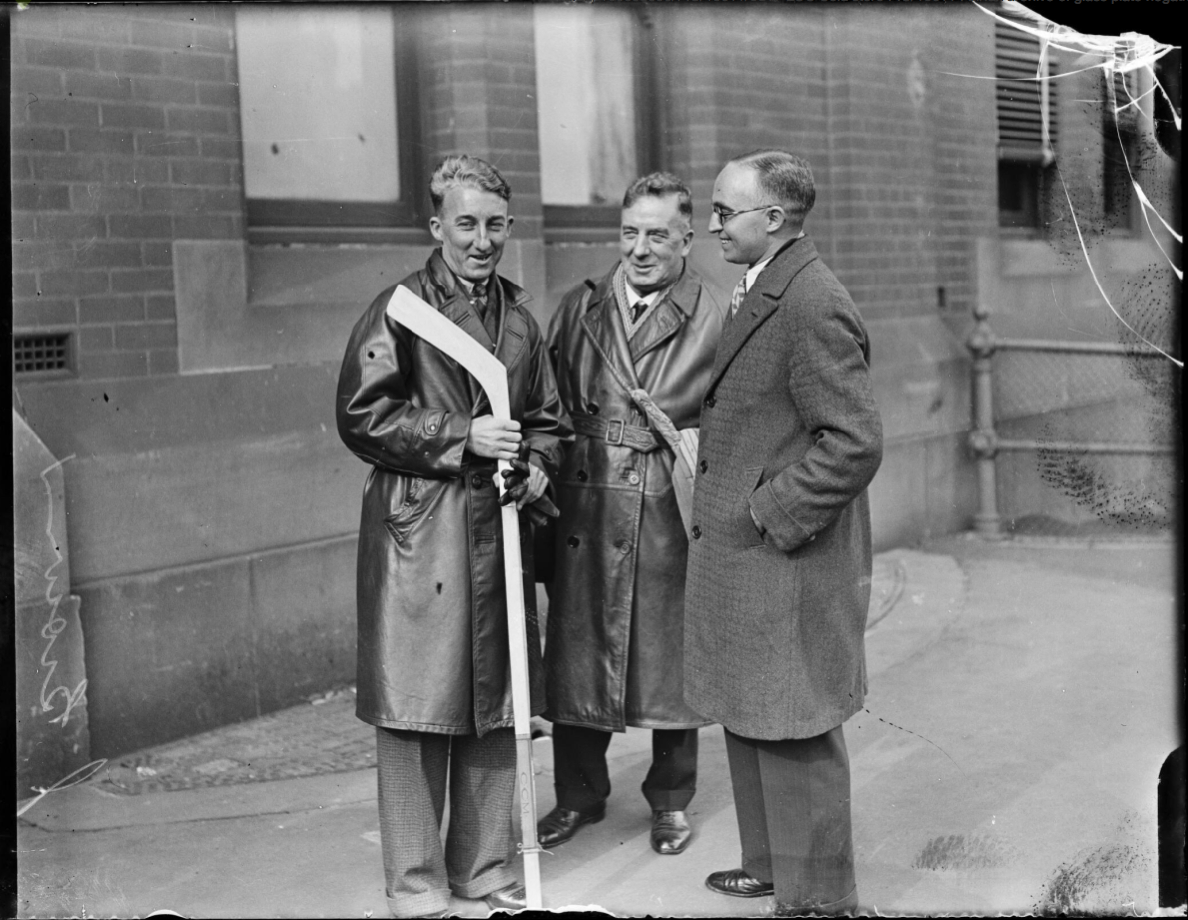
Left to right: Jim Brown, "Buster" Brown and Doc Murphy, Sydney, 6 June 1931. Brown had just returned from England where he played ice hockey in the English National League and broke the British speed skating record for the one-mile championship. He was 23 years-old. National Archives Australia.
[ HOCKEY ] A hotel someplace
Juniors in search of excellence
![]() While it cannot be denied that ice hockey is the fastest game in the world, it must be conceded that Australians have not reached the speeds attained by the crack Canadian combinations. Still, the Australians are not far behind them, and some of our best men would hold their own in teams in the Dominion. Where practice can be had at almost any time of the year, it is natural that the game should have grown apace and that crowds at between 20,000 to 40,000 people should gather to witness the matches...Though several suggestions have been made to bring some of the Canadians here, nothing has been done owing to the heavy expense that would be incurred. It would not be wise to bring only one team. Two teams to play exhibition games would cost so much that it would be almost impossible to finance the tour. It may become possible, but at present the possibility seems very remote. We can only improve our own game here and hope that some day we may match a Canadian combination.
While it cannot be denied that ice hockey is the fastest game in the world, it must be conceded that Australians have not reached the speeds attained by the crack Canadian combinations. Still, the Australians are not far behind them, and some of our best men would hold their own in teams in the Dominion. Where practice can be had at almost any time of the year, it is natural that the game should have grown apace and that crowds at between 20,000 to 40,000 people should gather to witness the matches...Though several suggestions have been made to bring some of the Canadians here, nothing has been done owing to the heavy expense that would be incurred. It would not be wise to bring only one team. Two teams to play exhibition games would cost so much that it would be almost impossible to finance the tour. It may become possible, but at present the possibility seems very remote. We can only improve our own game here and hope that some day we may match a Canadian combination.
— Ted Molony, captain of Victoria, 1928. [2]
![]() One Victorian ice hockey association, having given up all hope of gaining Olympic recognition, is going to pool its resources with similar bodies in Tasmania and Sydney. The three will form a National League, with the idea of importing overseas stars to make the sport something to queue up for. Other night promoters had better pull up their socks.
One Victorian ice hockey association, having given up all hope of gaining Olympic recognition, is going to pool its resources with similar bodies in Tasmania and Sydney. The three will form a National League, with the idea of importing overseas stars to make the sport something to queue up for. Other night promoters had better pull up their socks.
— Ken Moses, sports journalist, 1951 [8]
![]() Players who break their line of development at home very often lose their national characteristics as they become hybrids — players with very few qualities that set them apart. Players who develop in their own environment until 21 to 23 (domestic league, national team experience) become better NHL players.
Players who break their line of development at home very often lose their national characteristics as they become hybrids — players with very few qualities that set them apart. Players who develop in their own environment until 21 to 23 (domestic league, national team experience) become better NHL players.
— World Hockey Summit, Toronto, 2010 [1]
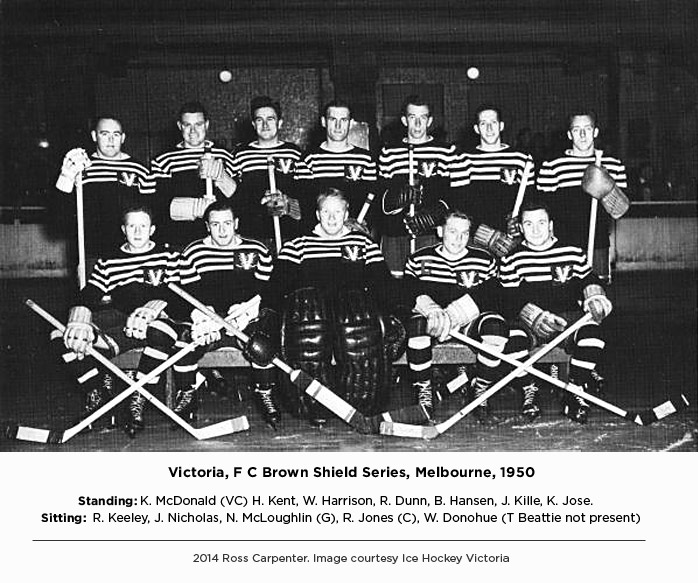
 HE SOUNDS OF THE CITY completely invaded the air of the half-opened room, waking the young men after having slept the sleep of the defeated for hours on end, oblivious to the pile of drying clothing, decaying travel bags and distressed hockey sticks rising like a deconstructivist set piece at its centre. Otherwise, it was a room like any other, in a hotel somewhere or a private home, in Tallinn perhaps, or Helsinki, Zagreb or Katawice, a room not far from the ice arena to where the young Australians must now return and fight to avoid the haunting eyes of their conquerers, their coaches, the overly polite faces of their hosts, the humiliation of relegation to a lower division, a lower world ranking, a lesser world than the one they had left just ten days earlier.
HE SOUNDS OF THE CITY completely invaded the air of the half-opened room, waking the young men after having slept the sleep of the defeated for hours on end, oblivious to the pile of drying clothing, decaying travel bags and distressed hockey sticks rising like a deconstructivist set piece at its centre. Otherwise, it was a room like any other, in a hotel somewhere or a private home, in Tallinn perhaps, or Helsinki, Zagreb or Katawice, a room not far from the ice arena to where the young Australians must now return and fight to avoid the haunting eyes of their conquerers, their coaches, the overly polite faces of their hosts, the humiliation of relegation to a lower division, a lower world ranking, a lesser world than the one they had left just ten days earlier.
Today, about one quarter of Australia's four thousand ice hockey players are juniors, but 'junior' usually referred to player ability and not age in the early years of the Australian game. Age limits were not considered for players until much later and a confusing practice of denoting reserve-grade players as juniors lasted well into the 1960s. For instance, a decision requiring all clubs to organize junior teams for a reserve-grade competition was recorded in the earliest New South Wales association minutes. [13] Yet, true juniors had played ice hockey in Australia since the very first game in which a puck was known to be used.
They were a team of Melbourne schoolboys against a team assembled from the ranks of the Canadian Junior Lacrosse Team on tour in Melbourne in 1907. The visit produced Australia's first international match in lacrosse before a crowd of thirty thousand at the MCG, but it also launched Australia's first encounter with junior ice hockey in its modern form. Australia's first juniors included sixteen year-old youngsters Bobbie Jackson, Hal Reid, and Dudley Forster Woods. [6] In fact, all of them, together with Goodall and the two other Reid boys, were still schoolboy juniors when they began Goodall Cup ice hockey. It took two decades and more before a true age-delimited, junior structure commenced, and much more before it reached national maturity and the international stage.
In the emergent game in Victoria at the turn of last century, there were no trophies specifically for junior players because all the players were juniors. The trophy for the minor premiership was another Goodall Cup; the women's ice hockey trophy was the Gower Cup from 1922; the VIHA premiership trophy was known as the Sutherland Cup from 1925 until replaced by the H H Kleiner Trophy after the second world war; and the VIHA speed skating trophy was known as the Singleton Cup. In Sydney, the prize of the State league was the Hamilton trophy from 1922 until 1935, after which it was renamed variously as the McGeahran Trophy, 1936-37; Buchan Trophy, 1938-40; Chalwin Trophy 1954-81; CP Air Cup, 1982-1999; and the current East Coast Super League trophy.
It was soon after the Great War that the already wealthy Jack Goodall became active in the administration of the Victorian game, when the Reid family left for Sydney, when the sport had finally resumed after the bloodiest of war interruptions, when the roaring twenties exploded onto the ice in a shower of Veuve Clicquot and world freedom. Goodall was only twenty-seven and had lost many of the foundation players to war, some never to return, others to raising families of their own.
Childless and fatherless himself, he guided the rebuilding of the decimated Victorian game; captained the last of the Victorian Goodall Cup champions for a quarter-century to come, paved the way for the first interstate women's ice hockey competition in 1922; and the first national association in 1923. He married a second time, retired as a player (returning briefly only for Kendall's farewell series), busied himself with setting the sport on a national footing, and dutifully presented the Goodall Cup at interstate tournaments.
After the Wall Street crash in October 1929, unemployment in Australia had doubled to twenty-one percent by mid-1930. Jack Goodall, himself a Queen Street stockbroker, returned in 1930 after a five year absence to head the VIHA, following the death of its president, Peter Ross Sutherland. In the depths of the Great Depression, Goodall presided over the re-organisation of the VIHA clubs with the aim of giving "young players a better chance to improve themselves". In the 1931 season, St Kilda IHC was dropped, and the three remaining clubs — Hawthorn, Brighton and Essendon — were restructured with both senior and junior teams. Seniors played Monday nights, and juniors on Thursdays. [5] The first inter-club juniors and the first inter-schools competition were both created that year, the first true, age-delimited junior ice hockey leagues in Australia.
The inaugural VIHA Junior Public Schools under-16 competition was won by Melbourne Grammar that same season. The league included Scotch College and Wesley College and games were played at the Glaciarium on Saturday mornings. [4] Although "schoolboys" had competed in "teams races" in Victoria since sometime before 1924, the Victorian speed skating championships under the control of the same association were simultaneously redefined in 1931, enabling boys and girls to compete in under-sixteen and under-eighteen junior age divisions. [3]
Players competed interstate during these years for the Goodall Cup, but also the return Interstate Ice Hockey trophy that was played yearly in either Victoria or New South Wales — wherever the Goodall Cup tournament was not. The "Return Goodall" was not a junior competition as we understand it today. It was intended to give players on the fringe of Goodall selection an opportunity to demonstrate their ability, although Goodall Cup players formed the nucleus of the tournament's teams. The Australian international, Jim Brown, presented the F C Brown Memorial Shield for this series in 1938, a memorial to his father, Francis Cowan "Buster" Brown, who had died two years earlier in 1936 at Petersham in Sydney. New South Wales were unbeaten in the first Brown Trophy series in Sydney, with players such as Tom Coulter, Jim Brown himself, and Brown's cousin, Jim McLauchlain. [11]
In the early-1930s, Brown had broken Australian and British ice racing records, earning the moniker, "Flying Jim Brown, The Meteor". He had represented England in the ice-hockey championship in Switzerland, playing against Canada, Switzerland and France, and he had also represented Great Britain in the ice sports at Davos, Switzerland, with conspicuous success. [10] Trained by Jim Kendall, he was a defenseman who represented New South Wales in the Goodall Cup from 1927 until 1946, often as captain, then became a manager and coach with the New South Wales association. Although he retired as a player at the age of thirty-nine, he continued in the sport as a selector and coach for New South Wales. Brown was the first Australian ice hockey player and speed skater to compete overseas, preceding Australia's first Winter Olympian by five years.
An earlier Brown Trophy had been donated by Buster Brown in 1928 for interstate speed skating, when that sport was still controlled by Australia's ice hockey associations. Over the first decade, it was won by New South Wales from 1928 to 1935, and Victoria from 1936 to 1938. [12] The inaugural year of the Brown Trophy was also the year the national association finally joined the International Ice Hockey Federation (IIHF). It was the same year that the first pressure was applied to commercialize the sport, the same year its first real threat emerged in the form of a rival association, and three decades to the year since the first controlling authority for the Australian game had been founded in Melbourne.
On the eve of world war came the second rink at St Kilda, along with inter-rink matches between the St Moritz and Glaciarium junior teams. [7] This fledgling junior house league "proved highly successful, and the standard of hockey was remarkable for first year players". Matches continued in Melbourne in 1940 and 1941 with the junior Topliners and the junior Flyers. [8] In Sydney, the management of the Glaciarium permitted a coaching class to be held every Sunday from 6 am to 8 am for players 16 years and under, coached by Fred James, Jim McLauchlain and later Syd Tange. Saturday coaching classes continued until the Glaciarium closed in 1955.
Melbourne had a similar approach, especially after the 1941 season, when competition hockey was finally suspended due to the war. In fact, the practice sessions at both Melbourne rinks over the following four years produced many of a new wave of youngsters, players like Rus Jones and Dave Cunningham, who were skilled enough to enter the war-decimated game immediately the competition was restored in 1946. A breakaway association, the Victorian Ice Hockey League (VIHL), had formed in 1948, and by 1949 there were a century peak of nine clubs, divided between two rinks and two associations. The first hockey had commenced in Western Australia and Tasmania, where State associations had been formed by 1951, and Tasmania became the third State to compete for the Goodall Cup.
When the Olympic Council did not recognise the second association in Victoria, it planned instead to pool its resources with similar bodies in Tasmania and Sydney to form a "National League". It imported overseas stars to increase the sport's appeal and gate revenue, the way Jimmy Bendrodt had done in 1938. [8] Many notable Internationals arrived, including a few of Europe's pre-war hockey elite, but the idea again fizzled out, and with it the many juniors who had begun the fledgling sport in Tasmania.
In 1950, Alwyn Stuart and Syd Tange discussed the prospect of a Junior Interstate Competition during a Goodall Cup series in Melbourne. Stuart was manager of the St Moritz rink and president of Pirates IHC in Melbourne, while Tange was then Secretary of the NSW Association. The controlling bodies approved, and New South Wales played Victoria during the Goodall Cup series at St Moritz on July 27th, 1951. It was a drawn match, 2-2, and Stamina Apparel Co donated the Stamina Trophy for the competition. Melbourne continued on with its junior program under the guidance of hard-hitting defenseman, Ken Pawsey, who became a member of the first Australian Olympic Team.
Incredibly, all hockey in Sydney lapsed after the Glaciarium closed in 1955, until intense lobbying of a local Council resulted in the Prince Alfred Park ice rink opening in Chalmers Street, Surrey Hills on June 2nd, 1959. The new open-air rink was managed by John Caruana who had run the old Glaciarium since 1948, and Sports Stadium Brighton in England, home ice to the ENLs Brighton Tigers IHC for 30 years, over which time it gained a reputation as one of the biggest sporting and entertainment venues in England. He was also associated with Earl’s Court, aka the Empress Hall, a major ice rink and entertainment arena in London with a capacity of seven thousand.
Caruana asked Tange to organise a special coaching class in a rink initiative designed to help re-establish NSW ice hockey. The eligible age limit was still 16 years and under. In 1960, more rinks had opened in Newcastle and in Sydney at Bondi Junction and Homebush. [15] Although they closed after just a few years, five more followed in Burwood, Ryde, Auburn, Canterbury and Narrabean between 1964 and 1967. Half of New South Wales' ten new rinks closed over the decade commencing in 1957, but they had provided practice ice at a time when there had been none. The first junior series was played in 1969 at Canterbury and the second at Prince Alfred Park. Canterbury was also begun as an open-air rink in 1966, then covered in 1968. It operated as a not-for-profit co-operative returning its income to rink operations. The Prince Alfred Park rink was demolished in 1993, and the area it occupied was absorbed into the pool enclosure.
In 1964, the Jim Brown Shield for Interstate junior (reserve) ice hockey was presented by the president of the NSW association, Harry Curtis. The inaugural tournament was held in Brisbane during the Warana Festival week and won by Victoria. The trophy was intended to perpetuate the memory of Australian ice hockey and speed skating legend, Jim Brown, with whom Curtis in Glebe IHC had competed on many occasions. Today, the Jim Brown Shield is presented as the Brown Trophy to the winners of the Australian open men's ice hockey championship (17+), in keeping with its traditional format for players on the fringe of the Goodall Cup competition. In earlier years, it had been presented to the Senior B Australian Championship winner.
Five years later in 1969, the national association introduced a junior national series for the Under-18 age band, following the formation and success of the NSW Homebush Juniors IHC among the various prior endeavours to organize interstate matches. The first series was played in 1969 at the Canterbury ice rink, and the second at Prince Alfred Park. Victoria won both games and John Horsnell of Victoria was named 'Best and Fairest'. The trophy was presented by three former NSW players and administrators Ken Kennedy, Jim Mortimor and Mark Murphy. It was their desire to name it after Sydney Tange whose interest in junior development had spanned twenty years.
Tange’s involvement in the sport had stretched back to 1937 when he joined the St George IHC. He played the sport for a decade until 1947, then made his mark as an administrator, first as secretary-treasurer of the Club, president of the Glebe IHC, president of the East Monarch IHC, assistant treasurer of the New South Wales association, and eventually secretary-treasurer for many years. He was awarded life membership of the state association in 1960, elected president from 1964 to 1966, and awarded the Hudson Trophy in 1967. He was also awarded life membership of the national association in 1962, where he later served as president from 1970 to 1973.
Although the rinks in Western Australia and Tasmania were almost as short-lived as Victoria's second association, the Goodall, Brown and Tange interstate competitions were no longer limited to the nation's two main cities. The boutique rink in Hindley Street, Adelaide, had opened in 1959 and Mowbray Park in Brisbane in 1961. Queensland and South Australia had commenced participation in the Brown trophy in 1964.
In 1965, the VIHA Demons played to capacity audiences in Adelaide while ABC Television screened two matches in Victoria that year and telecast the VIHA Grand Final. [14] South Australia began competing nationally some time after the international-size rink at Payneham opened in Adelaide's north-east in 1979. The Australian Capital Territory had a rink at the Canberra Showgrounds between 1968 and 1975 and the rink at Phillip opened in 1976. By the early-1980s, the ACT was competing nationally.
At the international level, the first official IIHF tournament for juniors (U20) was not held until 1977, and it was dominated by the world's hockey powers, just like the seniors. The IIHF compensated with three lower divisions of separate tournaments where the winner is promoted to a higher division, and the team placed last is relegated to a lower division.
In 1980, the National Ice Hockey League (NIHL) formed for three seasons with teams from Sydney, Newcastle, Adelaide and four from Victoria. It was another ill-fated attempt to commercialize the sport, based yet again on a huge influx of imported players, mostly from Canada. None were professionals and, according to organisers, most were more interested in a holiday in the sun than hockey. [17] By 1982, the NIHL was shut-down by a national association led by Phil Ginsberg on the grounds that it was violent. In retrospect, there is little evidence in Australia's performance on the world stage to suggest the NIHL did anything for junior development. They were diametrically opposed.
In 1983, Australia competed for the first time in the IIHF Junior (U20) World Championships, and again in 1987, losing all their games. Australia did not return to the Junior Worlds until 2000. The international tournament for youth (U18) on Australia's side of the world, began as the IIHF Asian Oceanic U18 Championship in 1984, and was played annually until 2002 when the competition merged with the IIHF World U18 Championships. Australia won Bronze in 1985 and 2001, both in South Korea, then Silver in 2002. The team qualified for the U18 Worlds in 2003, five years after the championships had commenced.
Also in 1983, the board of the national association introduced a new classification called the President's Cup for players 13 years and under. The inaugural series was hosted in Adelaide and the original trophy was presented by the president of the national association, Philip Raleigh Ginsberg AM (1923 - 1998). The President's Cup was renamed in his memory after his death in 1998 at Balmoral Beach, NSW. He was a life member of the association who had held office since 1981. Born in Wellington, New Zealand, his Medal of the Order of Australia was conferred on June 10th, 1985 at Mosman, NSW 'for service to the sport of ice hockey'.
Two years later in 1985, the national association created an Under-15 interstate series dedicated to the late Kurt De Fris AM (1910 - 1983), who had long presided over the Victorian Ice Hockey Association. His interest in ice hockey had begun in 1955 as manager of the newly formed Arkana IHC based at Melbourne Glaciarium, and vice-president of the Victorian Ice Hockey Association (VIHA), later succeeding Bud McEachern as president for seventeen years.
Arkana IHC was soon sponsored by the Hakoah Sports Club, eventually becoming Hakoah IHC. De Fris was elected to the Club's committee of management and vice-president of the VIHA the same year, becoming honorary life president in his retirement. De Fris held diverse sporting interests all his life, and he is considered the founder of the Hakoah sports movement in Australia, a club dedicated to the philosophy of Muscular Judaism. He was inducted to the Maccabi Victoria Hall of Fame in 2000, and made a Legend in 2011.
When Australia returned to the World Juniors after an absence of 13 years, they won their first ever international match. Overall they have won only twenty-eight percent of all their games from seventeen Worlds appearances. Ranked 20th in the world when they started, they were ranked 31st by 2015. The National Youth Team (U18) were ranked 34th in the world from thirteen appearances by 2015, which is about where they started. Both have now been participating internationally for well over three decades.
Although today's national junior tournaments were formed in the 1960s and 1980s, [16] the ethos that drives them has evolved for well over a century, from the first schoolboy encounters with North Americans in the 1900s, through the first junior inter-club competitions in Victoria during the early-1930s, to inter-rink competitions and interstate contests, initially in the two biggest cities, and eventually every State. This history, this bloodline, this characteristic spirit and culture of Australia, this grit and authenticity, cannot be purchased with a travel visa or dual nationality, even if it was for sale.
It's a battered old suitcase to a hotel someplace, and a world competitiveness we must master. Australia's national junior and youth squads matter for as long as we want our national senior team to be populated by Australian-born players. Yet, there is also clear evidence that a good deal more is involved in a world class junior development program than participation in national and international tournaments. The formation in 2012 of a national junior league, as a prerequisite to Australia's continued participation in the World Juniors, is one good example.
![]()
Image [slideshow above]: Australian National Team Logo Concept, Hypergrafika, 2015
This is Australia (The Sounds of Then), Gang Gajang, Coca Cola ad, 1988.
Shanghai Ghetto: Kurt Defris AM
The First Commercialisation of Ice Hockey in Australia: Bendrodt's Bears
Australia's Red Letter Day: March 15th 1962
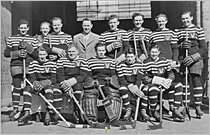
Alwyn Stewart and the Victorian Junior Team, 1940s [18]
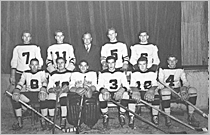
Victorian Ice Hockey League (VIHL) players, 1950. [18]
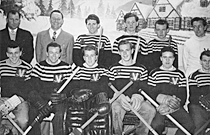
Syd Percy and the Victorian Junior Team, 1951 [18]

Doug Parker and the Victorian Junior Team, 1952 [18]
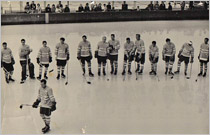
NSW winning back the Goodall after 4 years without rinks, 1963. Captain Rob Dewhurst out front. [19] Roster
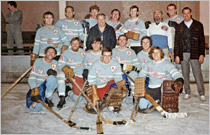
New South Wales Brown Trophy Champions, 1970. [19]
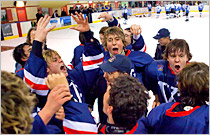
Victoria Tange Trophy Champions, 2009. L to R: Bourke, McKenzie, Carpenter; coach Simon Holmes in cap
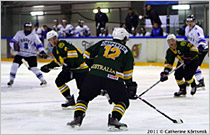
National Junior Team vs Estonia, Tallinn, 2011. L to R: Humphries, Carpenter and Kyros
Citations:
[1] World Hockey Summit, Junior Development Around the World, Slavomir Lener, Toronto, 2010.
[2] Sporting Globe, Melbourne, 4 Aug 1928, p 6.
[3] "Ice Hockey: The NSW Ice Hockey, Association Inc. Australia - Facts and Events 1907-1999" by Sid Tange, 1999. Extracts published in 2007 on the IHNSW web site for the 2008 Centenary.
[4] The Age 20 June 1932, p 4. "Melbourne Grammar Defeat Scotch College". Also see The Argus, Melbourne, Mon 27 Jun 1932, p8 and The Argus, Melbourne, Mon 11 Jul 1932, p4.
[5] Advocate, Melbourne, 21 May 1931, p 31. "The Glaciarium".
[6] The Age, Melbourne, 13 Aug 1907, p 4. "Hockey at the Glaciarium".
[7] The Age, Melbourne, 4 September 1939, p 4, "Junior Players Show Promise", and 25 September 1939, p 6, "Junior Match".
[8] The Age, Melbourne, 23 July 1940, p 4, "Junior Ice Hockey".
[9] The Argus, 3 February 1951, Ken Moses Column
[10] Table Talk, Melbourne, 4 June 1931 p 36.
[11] The Sydney Morning Herald, 29 September 1938, p 16.
[12] The Sydney Morning Herald, 11 Aug 1938 p 16.
[13] Tange, 1999, Ibid. New South Wales Ice Hockey Association, Minutes of Meeting, March 21st, 1923.
[14] Australian Ice Hockey Carnival program, NSW Ice Hockey and Sports Club Ltd, 1965, p 11.
[15] Ice Hockey Week, Official Programme, NSW Ice Hockey Association, May 1961.
[16] A tournament for the 11 and under age band named after John McRae Williamson was conducted between 2003 and 2010, but it became a Jamboree and is no longer a competition.
[17] The Christian Science Monitor, Sydney, 17 May 1982. "Alien sport of ice hockey gains Australian beachhead", by Chris Pritchard.
[18] Image courtesy of Basil Hansen, Ice Hockey Victoria.

